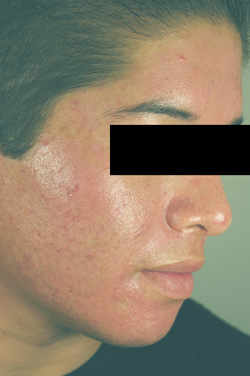Have you heard of photodynamic therapy (PDT) for the treatment of acne? Chances are that if you have severe acne or you have failed multiple other conventional acne therapies that you have. ALA stands for aminolevulinic acid, the light sensitizing medication that is used in the treatment. PDT stands for photodynamic therapy, which is the more descriptive of the procedure since it involves both the use of medication and light together to improve your acne.


PDT with ALA can be an extremely effective treatment for many skin problems including acne. Many acne patients choose PDT not only because they failed traditional acne treatments, but because they could not tolerate the side effects of powerful acne medications such as Accutane. And while the results for photodynamic therapy can be impressive and many patients do very well after treatment, it’s important to share with you that it is not a treatment without potential side effects.
Post Inflammatory Hyperpigmentation or PIH as it is commonly referred to is the main potential side effect of PDT. We see this side effect in about 20% of our patients, mostly in those with medium or darker skin types (colors). PIH with PDT can happen as a normal response to the intense inflammation triggered by treatment. It can be a persistent red color in lighter skin types, or brown discoloration with medium and dark skin types.
The good news is that it doesn’t last for long. Usually within a few weeks, it resolves on its own. On occasion, we’ve had to use other treatment options to help speed resolution.
Closed comedones or whiteheads can also flare up in response to PDT treatment. We see this commonly in clusters around the mouth and jawline. Although we aren’t totally sure why this happens, it is believed it may be the skin’s response to the healing hair follicles. Hair follicles are joined to an oil/sweat duct which takes up and stores the ALA during the treatment.
Unlike PIH, which is rare, small comedones around the mouth and jaw happens in most of our patients. In fact, we tell them to expect it during their consultation. While it worries most to see an “acne-like” breakout just after an intense treatment for acne, it doesn’t last long. One to two weeks in most cases is the norm and it typically disappears without any special treatments or products.
At Celibre Medical, we routinely use PDT with ALA therapy for the treatment of severe and/or resistant acne and we believe it’s an invaluable procedure. We’ve seen it help hundreds of patients over the years. But it is a procedure that has the potential for some side effects, and we do our best to always discuss this in-detail and up front with anyone considering it.

